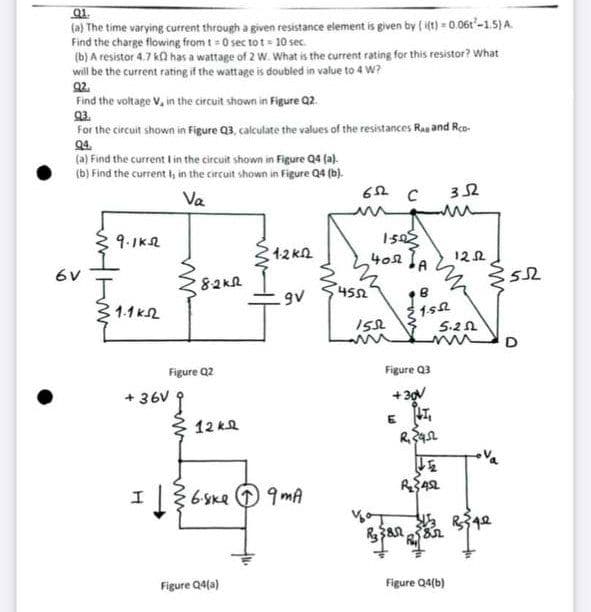(a) The time varying current through a given resistance element is given by ( it) = 0.06t'-1.5)A. Find the charge flowing from t=0 sec tot 10 sec (b) A resistor 4.7k0 has a wattage of 2 W. What is the current rating for this resistor? What will be the current rating if the wattage is doubled in value to 4 W?
(a) The time varying current through a given resistance element is given by ( it) = 0.06t'-1.5)A. Find the charge flowing from t=0 sec tot 10 sec (b) A resistor 4.7k0 has a wattage of 2 W. What is the current rating for this resistor? What will be the current rating if the wattage is doubled in value to 4 W?
Introductory Circuit Analysis (13th Edition)
13th Edition
ISBN:9780133923605
Author:Robert L. Boylestad
Publisher:Robert L. Boylestad
Chapter1: Introduction
Section: Chapter Questions
Problem 1P: Visit your local library (at school or home) and describe the extent to which it provides literature...
Related questions
Question

Transcribed Image Text:(a) The time varying current through a given resistance element is given by ( it) 0.061-1.5) A.
Find the charge flowing from t = 0 sec tot= 10 sec.
(b) A resistor 4.7 ka has a wattage of 2 W. What is the current rating for this resistor? What
will be the current rating if the wattage is doubled in value to 4 W?
Q2.
Find the voltage V, in the circuit shown in Figure Q2.
for the circuit shown in Figure Q3, calculate the values of the resistances Ras and Rco.
(a) Find the current I in the circuit shown in Figure Q4 (a).
(b) Find the current i, in the circuit shown in Figure Q4 (b).
32
Va
1593
402 lA
9.1K2
12k2
122
6v
452
11k2
5.2 n
Figure Q2
Figure Q3
+ 36V
+30
12 ka
9 mA
Figure Q4(a)
Figure Q4(b)
Expert Solution
This question has been solved!
Explore an expertly crafted, step-by-step solution for a thorough understanding of key concepts.
Step by step
Solved in 3 steps with 3 images

Knowledge Booster
Learn more about
Need a deep-dive on the concept behind this application? Look no further. Learn more about this topic, electrical-engineering and related others by exploring similar questions and additional content below.Recommended textbooks for you

Introductory Circuit Analysis (13th Edition)
Electrical Engineering
ISBN:
9780133923605
Author:
Robert L. Boylestad
Publisher:
PEARSON

Delmar's Standard Textbook Of Electricity
Electrical Engineering
ISBN:
9781337900348
Author:
Stephen L. Herman
Publisher:
Cengage Learning

Programmable Logic Controllers
Electrical Engineering
ISBN:
9780073373843
Author:
Frank D. Petruzella
Publisher:
McGraw-Hill Education

Introductory Circuit Analysis (13th Edition)
Electrical Engineering
ISBN:
9780133923605
Author:
Robert L. Boylestad
Publisher:
PEARSON

Delmar's Standard Textbook Of Electricity
Electrical Engineering
ISBN:
9781337900348
Author:
Stephen L. Herman
Publisher:
Cengage Learning

Programmable Logic Controllers
Electrical Engineering
ISBN:
9780073373843
Author:
Frank D. Petruzella
Publisher:
McGraw-Hill Education

Fundamentals of Electric Circuits
Electrical Engineering
ISBN:
9780078028229
Author:
Charles K Alexander, Matthew Sadiku
Publisher:
McGraw-Hill Education

Electric Circuits. (11th Edition)
Electrical Engineering
ISBN:
9780134746968
Author:
James W. Nilsson, Susan Riedel
Publisher:
PEARSON

Engineering Electromagnetics
Electrical Engineering
ISBN:
9780078028151
Author:
Hayt, William H. (william Hart), Jr, BUCK, John A.
Publisher:
Mcgraw-hill Education,